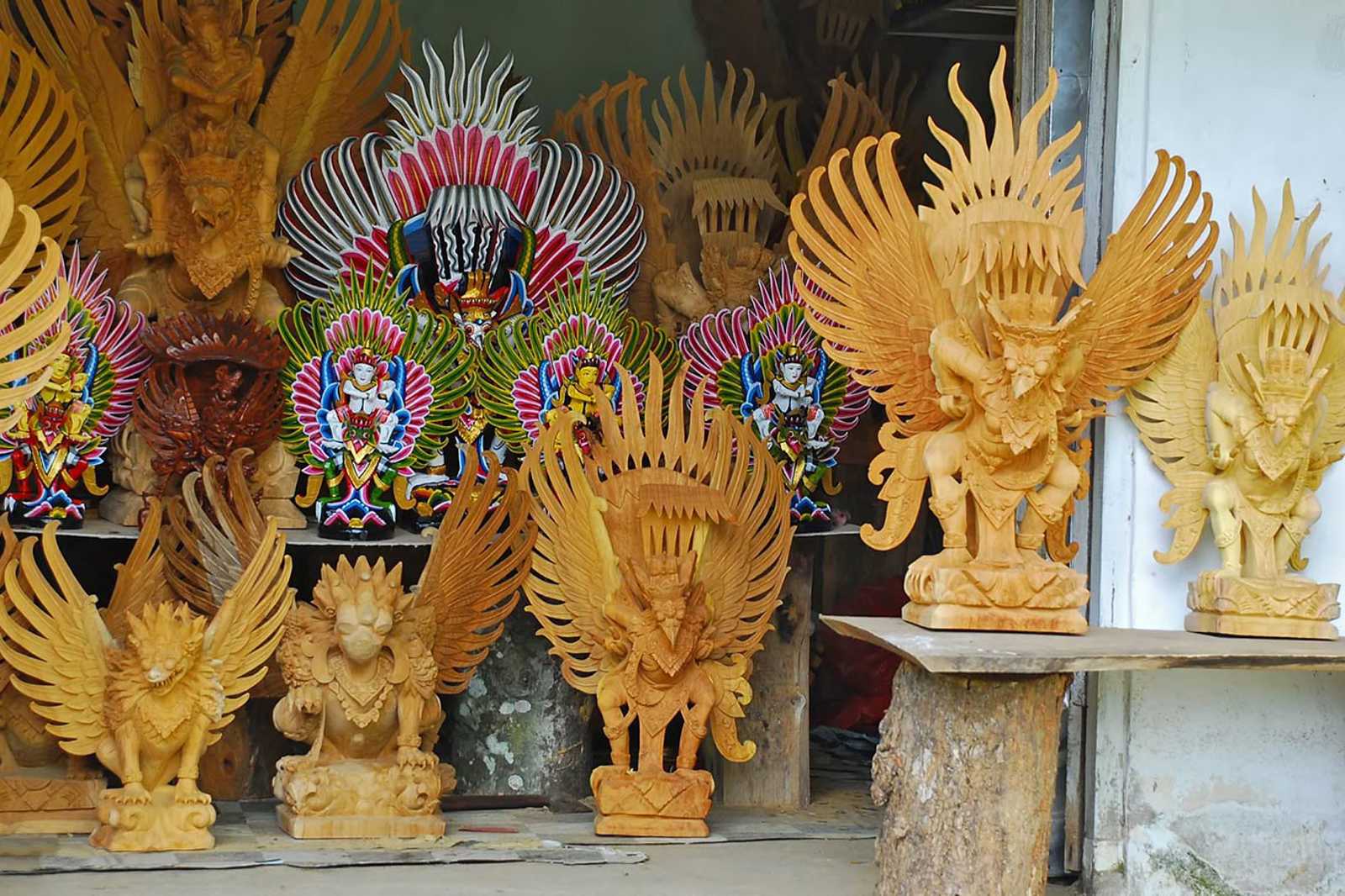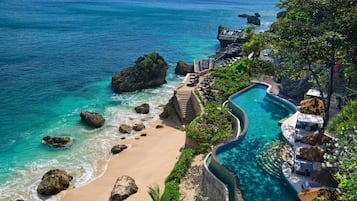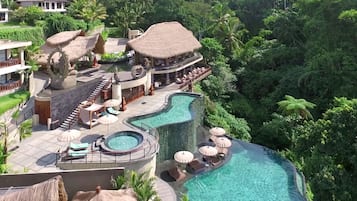There are some great Bali souvenirs worth bringing home, which are better alternatives to the usual ‘stupid things’ people buy while holidaying on the island. We aren’t talking about the colourful and kitsch stuff you find at most roadside art shops, or those fake watches, sunglasses and other crummy fashion accessories that usually get pushed in your face by roaming peddlers on the beach.
Nope, these are the real deal – good as personal keepsakes and mementos of your last Bali holiday and even better as décor for your living room or as truly special gifts for folks back home. Choose from majestic masterpieces created by skilled Balinese artisans or gold or silver jewellery that are ‘unmistakably Bali’ souvenirs.
- 1
Silk batiks and rare traditional textiles

- Tín đồ mua sắm
While those highly colourful beach sarongs sold by peddlers on the beach can be tempting and even useful for sunbathing on, they’re mostly low-quality prints. For authentic silk batiks that look good on your upholstery back home, invest some time browsing fine batik showrooms and manufacturers around the Batubulan area, such as Popiler Batik. You can even enrol for a fun batik course to make your own piece!
Other Balinese fabrics to look out for are ikat, Bali’s own legendary geringsing, endek and the elaborate songket – all traditionally produced in villages in East Bali. Threads of Life in Ubud, is a gallery that is well worth a visit for its wealth of authentic heritage textiles from Bali and the Nusa Tenggara islands.
Where to buy: Tenganan Village, Popiler Batik, or at batik showrooms in most modern malls in Bali
How much: from Rp 160,000 to Rp 20 million a length - Tín đồ mua sắm
Đọc thêmArt buffs know that Balinese paintings are well done and come in a variety of styles. There’s one particular Balinese painting that has a lot of value: the Kamasan-style works from the namesake village in Klungkung, East Bali. It’s one of the most traditional of Balinese paintings, dating back to the 16th century Gelgel kingdom, and mostly depicts wayang or shadow puppet forms, long before the influence of western artists in the 20th century. Interestingly, some are like comic strips, featuring scenarios from Hindu epics such as the Mahabharata or Ramayana – certainly something to spark conversation back home!
Địa điểm: Kamasan Village and the market near Kerta Gosa Hall of Justice
Giá: from Rp 500,000 to Rp 5.5 million for a standard 1-metre painting
- 3
Genuine Balinese woodcarvings

- Tín đồ mua sắm
Balinese sculptors are a special breed of artists, known for their 3-dimensional masterpieces in wood. There’s one place to go to find this kind of artistry in its truest form. The village of Tegallalang, just a short drive north from Ubud central, is home to a commune of woodcarvers who are known for the intricately stylised Balinese renditions of the Garuda, the mythical Hindu bird that is the mount of Lord Vishnu.
Other creations include anything from Balinese masks to wild animals and wooden tropical fruits. Sizes vary, with larger items available in knock-down segments that you can package and reconstruct at home.
Where to buy: Pakudui Village in Tegallalang, north of Ubud
How much: depending on size, from around Rp 135,000 to Rp 1.5 million - 4
Balinese coffee

- Ẩm thực
- Tín đồ mua sắm
Balinese coffee is readily sold in packages and as souvenirs in Bali, either in whole bean or ground form and even as hard candies (a popular brand widely sold here is Kopiko). The varieties of Robusta and Arabica beans sold here come from the best Indonesian growing islands, such as Gayo and Mandaling (North Sumatra), Java (obviously from Java), Mangkuraja (Bengkulu Islands), Kalosi (Toraja Island), and Bali’s own Kintamani.
For some high-quality Bali coffee, including the so-called ‘world’s most expensive coffee’ (Kopi Luwak, also known as 'civet cat-poop coffee'), you can try the Kopi Bali House – home of Bali’s legendary Butterfly Globe Brand. They’re also widely sold in convenient packets at supermarkets.
Where to buy: Kopi Bali House, or at souvenir shops and supermarkets island-wide
How much: from around Rp 56,500 for 250g packetsẢnh của Rudy Herman (CC BY 2.0) đã điều chỉnh
- 5
Gold and silver

- Cặp đôi
For one-of-a-kind jewellery items, try visiting Bali’s famous gold and silversmith villages of Celuk and Mas, right between the areas of Batubulan and Ubud. There are numerous showrooms and workshops here, such as Prapen Jewellery, where you can tour their workshop and get a closer look at the painstaking process of making a gold or silver pendant. Some workshops even offer fun courses where you can learn to make your own small piece, like a ring or bracelet.
Silver showrooms feature décor items small enough to fit in your luggage, including miniature silver temples, sailing ships, horse and carriages, and figures depicting Balinese life.
Where to buy: Prapen Jewellery and villages of Celuk and Mas
How much: small earrings from Rp 150,000 a pair - 6
Balinese spa stuff

- Tín đồ mua sắm
Bring a bit of that Balinese spa sensation back home with you, be it a vial of essential oil, incense sticks (including pretty ceramic burners), aromatherapy massage oils or organic soaps. Certain tropical flower fragrances, such as frangipani and jasmine, can be found in just about any BodyShop outlet or in other Southeast Asian spa destinations, but the Indonesian herbal jamu and Bali’s own spicy boreh body scrub are quite unique.
Where to buy: most major standalone and in-resort spas in Bali offer their own spa products for purchase
How much: from Rp 65,000 for a 5 ml vial of essential oil, Rp 30,000 for a tub of ‘boreh’ body scrub - 7
Ceramics

- Tín đồ mua sắm
For one-off tabletop décor, you can count on Bali’s selection of creative ceramic producers, such as Jenggala Keramik in Jimbaran. Fluid and organic shapes, inspired by tropical flowers and plants, are translated into high-quality bowls, vases, plates and many other tableware items.
Other well-known Bali-based producers that might be behind the unique, specially commissioned tableware of your villa include Gaya Ceramic in Sayan and Kevala Ceramics in southern Bali. You might also come across unique items by cottage industries, sold at art markets at bargain prices.
Where to buy: Jenggala Keramik, Gaya Ceramics, Kevala Ceramics and at various art markets
How much: from Rp 10,000 for a single, small item, to Rp 6 million for a premium, 20-piece tableware set - 8
Homeware items

- Tín đồ mua sắm
Balinese woodcarvers can sculpt such intricate statues, so it’s no wonder they can produce much simpler but equally wonderful wooden homeware and utensils as well. These range from bowls and spoons – smoothly shaped from jackfruit wood, teakwood roots or coconut shells – to coasters, placemats and reed baskets in many different sizes. They’re all available in single colours or vibrant rainbow patterns.
Where to buy: souvenir shops, art markets and homeware shops
How much: from Rp 150,000 for a small woven fruit basket - 9
Spices

- Ẩm thực
- Tín đồ mua sắm
The secret behind the flavours and aromas of local Balinese and Indonesian cuisine lies in its use of rich and exotic herbs and spices grown in the island’s beautiful tropical climate. In fact, the spice trade had colonists fighting over the islands in the Indonesian archipelago for centuries.
Fortunately, in this day and age, there’s no reason for warring over chillies. You can easily bring some of that spiciness home with you, with the many different spices sold in nifty packets at traditional markets and modern supermarkets. There are even ready-made sambal dips, bottled fresh and easy to pack in your bag.
Where to buy: in almost all Bali morning markets and major supermarkets
How much: from as cheap as Rp 5,000 for a small packet of ground coriander - 10
World-class designer fashion

- Tín đồ mua sắm
Bring home a great piece of tropical wear from any of the world-class Bali-based fashion designer boutiques. Paul Ropp is a label that Bali-bound fashionistas should have on top of their lists. You’ll easily find one of their high-end boutiques in the major resort areas such as Ubud and Seminyak.
Inside, you'll find handmade ‘head-to-toe’ fashion items for women and men, mostly made from handwoven and hand-dyed cotton and silk. The designs and creations by its eponymous New York designer are all funky and brightly coloured, somewhat harking back to the styles of the ‘60s and ‘70s. All fabrics and materials are handmade and produced using traditional techniques, though most are made in India. You'll also find a collection of jewellery and accessories, ranging from ornamental belts, dangle earrings and bangles made from cotton and silk.
Where to buy: Paul Ropp, Biasa and Thaikila to name a few
How much: Paul Ropp's fashion accessories cost from Rp 900,000




















